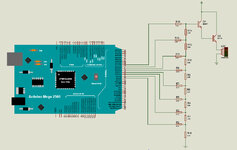fm101
Member level 5

hi,
I followed the tutorial here
exactly and the code is provided below but the audio output from speaker is like cracking sound white noise only. I have used BD135 as the second transistor and used 4.7k and 2.2k ohm resistors for the R-2R DAC.
The circuit and sound produced is as shown the video below.

the arduino code is attached because it was too long to post here(due to audio sample).
can anybody tell me why is the sound like that and what i should do?
thanks
I followed the tutorial here
The circuit and sound produced is as shown the video below.

the arduino code is attached because it was too long to post here(due to audio sample).
can anybody tell me why is the sound like that and what i should do?
thanks



